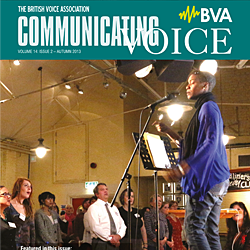About the Association
Archived book reviews
Choral Pedagogy
Brenda Smith and Robert Thayer Sataloff
Singular/Thompson Learning, 2002. ISBN 0769300510
Review by Ivor Flint
Apart from some obvious cultural differences between the UK and North America, Choral Pedagogy is an exceptional handbook for choral directors, musical directors, singers and teachers alike. For those with a good knowledge of vocal anatomy and mechanics it serves as useful revision, and for those with limited or none at all it supplies a comprehensive guide that will, hopefully, inspire the reader to learn more.
The book is well structured and the illustrations and language clear and straight-forward. Some of the more general statements about choral directors and singers are rather generous, but it is probably far better to take a non-adversarial approach to your readers than constantly remind them of the things they do wrong!
The anatomy and physiology chapter at the beginning of the book for the uninitiated is challenging, but necessary, leading logically to the chapter on medical care of voice disorders co-written by Mary Hawkshaw. This provides a useful brief guide to diagnosis, care and treatment of voice disorders, within the context of the book.
Richard Norris's short chapter on "Seating Problems of Vocalists" supplies useful practical information on posture, all too frequently overlooked (in my opinion), and Richard Miller's Historical Overview of Vocal Pedagogy provided an interesting diversion from the main text.
The concluding four chapters supply good practical exercises on preparing a choir to sing, starting with the issue of corporate breathing, progressing to the development of choral tone, including an overview of voice types and ranges, with some insightful comments and advice on managing sopranos, altos, tenors and basses, although I'm not quite sure that I would necessarily agree with the statement that "lower voices tend to be less flexible than higher ones, the bass being the least flexible". However, thinking back to some of the choirs I have worked with in the past I can quite see the value in making such a statement; after all, it is better to prepare a new choral director for the worst than paint an over-rosy view of the world of choral singing.
The final chapter "Rehearsal Techniques" is an excellent best practice model for developing any choir, and like any teaching model, if used sensibly rather than dogmatically will stimulate good musicianship and the subtle balance between independence of parts and unity, essential in choral singing.
This is a fine and highly recommendable comprehensive, well-informed hand-book, essential for anyone involved with choral singers. It is clear, insightful and practical, and a good reference book to have around. The writing is direct, intelligible, packed with well-presented, organised information and supported with a glossary and bibliography.
More archived content online
Disclaimer
Neither the British Voice Association nor the Editor can be held responsible for errors or any consequences arising from the use of information contained in its newsletters (or extracts from its newsletters published online); the views and opinions expressed do not necessarily reflect those of the British Voice Association (BVA) or the Editor, neither does the publication of advertisements constitute any endorsement by the BVA or Editor of any products or services featured.

 Join us Now!
Join us Now! our newsletter
our newsletter free voice care leaflets & information – download here
free voice care leaflets & information – download here Help our work by donating while you shop
Help our work by donating while you shop